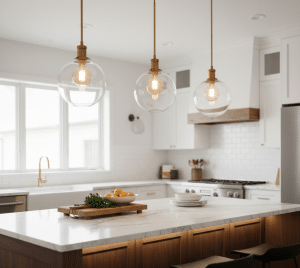Basements often get a bad reputation as dark, damp spaces unsuitable for plants. Yet, with the right selections and care, your basement can host thriving greenery.
This guide helps you choose plants adapted to lower light while managing basement humidity challenges.
You’ll find out which plants work best underground, learn essential care techniques, and find creative display ideas for maximum impact.
If you want to improve air quality, reduce dampness, upgrade your décor, or bring nature into your basement, the right plants can upgrade this often-neglected space into a welcoming part of your home.
What to Look for When Choosing Basement Plants
Picking the right plants for your basement means thinking about the special conditions found in below-ground spaces.
Not all plants will do well there, so it’s important to know what to look for when making your choices.
Light
Most basements get very little natural light. Look for plants that handle low-light conditions well, such as snake plants, ZZ plants, pothos, and peace lilies.
If your basement has no windows, consider adding grow lights – even low-light plants need some brightness to survive.
Humidity
Basements often have higher humidity than the rest of the house. This can be both good and bad for plants. Some plants, like ferns and peace lilies, enjoy the extra moisture in the air. Others might suffer if the air is too damp.
To manage humidity:
- Check if your basement needs a dehumidifier.
- Make sure pots have good drainage holes.
- Use a moisture meter to check soil wetness before watering.
- Space plants apart so air can flow between them.
Temperature
Basements can experience big temperature changes, especially in areas with hot summers and cold winters.
Most house plants prefer steady temperatures between 65-75°F. In winter, basements can get quite cold, especially near outside walls or windows. Some plants handle cooler temperatures better than others.
The cast iron plant and snake plant can both deal with cooler spots. If your basement gets cold in winter, keep plants away from drafty windows and consider moving more tender plants upstairs during the coldest months.
Maintenance
When choosing basement plants, look for ones that need minimal attention. You want plants that:
- Doesn’t need frequent watering.
- Can handle missed care now and then.
- Grow slowly in low light.
- Rarely need repotting.
Remember that plants in low-light conditions grow more slowly and use less water, so they need less frequent watering and fertilizing than plants in brighter areas.
Basement Plants that Thrive in Low-Light Conditions
Not all plants can handle the dim conditions of a basement, but some houseplants are naturally built for these challenging spots.
Here’s a list of plants that will not only survive but can actually grow well in your basement’s lower light levels.
1. Snake Plant (Sansevieria)

Light Requirements: Low to bright indirect light.
Care: Snake plants are nearly impossible to kill. They need watering only when the soil is completely dry.
The Washington Post notes these plants are perfect for small spaces like basements. Their tall, striking leaves add visual interest even in dark corners.
2. ZZ Plant (Zamioculcas zamiifolia)

Light Requirements: Low light.
Care: ZZ plants are among the toughest houseplants available. They store water in their thick stems and roots, allowing them to go weeks without water.
Their shiny leaves stay green even in poor light, making them a top choice for basement dwellers.
3. Peace Lily (Spathiphyllum)

Light Requirements: Low to medium light.
Care: Peace lilies tell you when they need water by drooping their leaves. They bounce back quickly after watering.
These plants add beauty with their white blooms that stand out in dark settings. They prefer slightly damp soil and occasional plant food.
4. Pothos (Epipremnum aureum)

Light Requirements: Low to medium light.
Care: Pothos plants have trailing vines that look great on shelves or in hanging baskets.
They grow well in low light and only need water when the top inch of soil feels dry. Reddit users often recommend these as starter plants for basement spaces.
5. Cast Iron Plant (Aspidistra elatior)

Light Requirements: Low light.
Care: True to its name, this plant is tough as iron. Léon & George highlight it as one of the best choices for basements due to its ability to handle both low light and high humidity.
Its wide, dark green leaves grow slowly and need minimal care.
6. Chinese Evergreen (Aglaonema)

Light Requirements: Low to medium light.
Care: Chinese evergreens offer beautiful patterned leaves that brighten dark spaces. RentHop lists them as ideal basement plants.
They like their soil to dry slightly between waterings and can handle the higher humidity often found in basements.
7. Spider Plant (Chlorophytum comosum)

Light Requirements: Low to medium light.
Care: Spider plants grow quickly and produce baby plants that hang down from the mother plant.
They need more water than some other basement plants but clearly show when they’re thirsty by becoming pale. Multiple Reddit threads list spider plants as good basement options.
8. Boston Fern (Nephrolepis exaltata)

Light Requirements: Low light.
Care: Boston ferns love basements’ higher humidity. Their soil needs to stay lightly moist, and they benefit from regular misting.
Their feathery fronds add a soft texture to basement spaces and help create a more natural feel in underground rooms.
9. Dracaena (Corn Plant)

Light Requirements: Low to bright indirect light.
Care: Corn plants (Dracaena fragrans) add height and style to any room. According to the source material, they “add a touch of elegance to any room of your home.”
They prefer their soil to dry out between waterings and can adjust to various light levels.
10. Lucky Bamboo (Dracaena sanderiana)

Light Requirements: Low to medium light.
Care: Lucky bamboo is very adaptable and can grow in either water or soil. RentHop includes it in their list of 7 basement plants that need little light.
It’s said to bring good luck and positive energy, making it a welcome addition to often-overlooked basement spaces.
11. Ferns (Plumosa Fern)

Light Requirements: Low light.
Care: Plumosa ferns have delicate, feathery foliage that softens basement décor. They need more attention to humidity than other plants on this list.
Regular misting or a humidity tray helps keep them looking their best in the drier months of the year.
Why Basement Plants are a Great Addition to Your Home
Plants can transform your basement from a storage space into a lively part of your home. They offer several key benefits that make them worth adding to this often overlooked area.
1. Reduced Humidity
Basements often have higher moisture levels than other parts of the home. Plants help by taking in water through their roots and releasing it through their leaves.
This natural process helps lower the dampness in your basement, making it less likely to grow mold. According to several sources, plants like peace lilies are especially good at reducing excess moisture in the air.
2. Enhancing Interior Design
Adding plants to your basement instantly makes the space more welcoming. The green touches bring life to an area that might otherwise feel cold or plain.
Even in low light, plants like snake plants and ZZ plants add visual interest with their unique shapes and textures.
As mentioned in the Stemhouse Floral Studio article, Dieffenbachias are popular for basement spaces because of their eye-catching leaf patterns that include various shades of white.
3. Improving Air Quality
Plants work as natural air cleaners. They take in carbon dioxide and release oxygen, making the air fresher to breathe.
Some basement-friendly plants are especially good at removing harmful substances from the air.
The search results highlight that certain plants can even remove airborne mold particles, which is very helpful in basement settings that might be prone to dampness and poor air flow.
4. Psychological Well-being
Having plants around makes people feel better mentally. Research shows that being near plants can lower stress, improve mood, and increase focus.
In a basement that might not get much natural light, plants create a connection to nature that helps people feel more relaxed and happy.
Many basement dwellers report feeling more at home and less closed-in when they add plant life to their space.
Essential Care Tips for Basement Plants
Taking care of plants in a basement requires adjustments to regular plant care. Here are the basics to keep your basement plants healthy.
Watering Tips
Plants in basements need less water than those in brighter spots. Lower light means slower growth and less water use.
Check soil moisture by inserting your finger about an inch deep – only water when it feels dry. As Fafard notes, “Plants that don’t get much sunlight don’t dry out as quickly.” Always empty standing water from saucers to prevent root rot.
Fertilizing
Use less fertilizer for basement plants. During spring and summer, apply fertilizer at half-strength and half as often as recommended.
Skip fertilizing in fall and winter when plant growth slows down. The source material clearly states to “reduce fertilizer applications, as plants in low light grow slower.”
Light Requirements
If possible, place plants near windows. For basements with limited natural light, add LED grow lights on timers for 8-12 hours daily.
Simple clip-on lights work for small plants, while shop lights with full-spectrum bulbs serve larger collections. As Capable Group mentions, ” If natural light is very limited, consider using grow lights to supplement the plants’ light needs.”
Temperature & Humidity Management
Keep basement temperatures between 65-75°F (18-24°C). For dry basements, group plants together, use pebble trays with water, or add a small humidifier.
Consider a dehumidifier to prevent mold in damp basements (over 60% humidity). The source material recommends monitoring for mold and mildew in basement settings.
Troubleshooting Common Basement Plant Problems
Even the hardiest basement plants can run into issues from time to time. Knowing how to spot and fix common problems will help keep your plants healthy in the long run.
Mold & Mildew
Mold and mildew often appear in damp basement conditions.
To prevent these issues:
- Improve air flow around your plants and avoid overwatering.
- If you notice white or gray fuzzy spots on soil or plants, remove the affected parts, repot with fresh soil if needed, and consider using a dehumidifier to lower moisture levels.
The sources specifically mention the importance of monitoring for mold in basement settings.
Yellow Leaves
Yellow leaves typically signal watering problems. In basements, this usually means overwatering rather than underwatering.
To prevent these issues:
- Let the soil dry out more between waterings, and check that your pots have good drainage.
- Yellow leaves can also occur when plants get too little light. If leaves are turning yellow despite proper watering, try moving the plant closer to a light source or adding grow lights.
Slow Growth
Slow growth is normal for plants in low-light conditions, but extremely slow or no growth might indicate problems.
To prevent these issues:
- Make sure your plant is getting at least some light – even low-light plants need some brightness to grow.
- Consider adding artificial lighting if growth has completely stopped.
- Also, check that you’re not overwatering, as waterlogged roots can’t properly absorb nutrients.
As mentioned in the source material, plants in low light need less fertilizer. However, they still need some nutrients—try a very diluted fertilizer once every few months during the growing season.
How to Enhance Your Basement with Plants
Adding plants to your basement can change how the space feels and looks. With thoughtful arrangement, even a few plants can make a big difference in creating a more welcoming area.
Using Plant Stands and Shelves

Place taller stands near windows to catch available light. Use stands of different heights to create visual interest and help light reach all plants.
Narrow shelves installed under basement windows can maximize limited natural light. Even a simple bench beneath a window can create an effective plant display that makes the most of the available light.
Hanging Plants

Hanging plants save floor space and make rooms feel larger. Trailing plants like pothos and spider plants work best in hanging baskets.
Install hooks in ceiling joists or tension rods between support beams. Place hanging plants near light sources so their vines can catch more light, adding life to often overlooked areas.
Grouping Plants

Create a plant corner by grouping plants with different heights, textures, and leaf shapes. Place larger plants at the back, medium-sized ones in the middle, and smaller plants in front.
Grouping also creates higher humidity, which benefits most plants. A collection of various plants on a table with a grow light can become a small indoor garden that brings life to your basement space.
Conclusion
Plants like snake plants, ZZ plants, pothos, and peace lilies make excellent additions to basement spaces, thanks to their ability to thrive in low light.
Remember to water less often, use minimal fertilizer, and monitor humidity levels for success.
If you place them on stands, hang them from the ceiling, or group them in corners, basement plants can turn an ordinary space into something special.
Start with just one or two easy-care options and watch how they change both the look and feel of your basement while helping to clean the air you breathe.













